A Guest Post by George Kaplan
Introduction
BOEM produces an estimate of GoM reserves every year. This year’s covers estimates for then end of 2017. Nominally The figures given are 2P estimates but previous analysis has shown them to be extremely conservative, and they strictly follows SEC rules concerning reserves being bookable only if clear development plans are in place.
Backdated Reserves
These charts show reserve additions from discoveries by depth (all backdated to the original discovery year so that all adjustments due to improved extraction methods and better understanding of the reservoir etc. are included in the shoen reserve estimate), production and remaining reserves also by water depth.
The black dashes against each discovery show the original estimates of reserves. The shallow water estimates were very low and had significant upgrades, deep water not so much, and ultra-deep hardly at all. The reason for this is mainly the date of the discoveries: nominally it should be easier to apply seismic and drilling analysis from shallow water but the ultra-deep finds were made later and therefore have had better technology and seismic available when the original estimates were made; more on this later.
That said I do not know what method BOEM uses to make the estimates, it cannot be the ultra high fidelity models that the E&P companies use as they do not have the computer power, human resources or time to cover every field in the GoM.
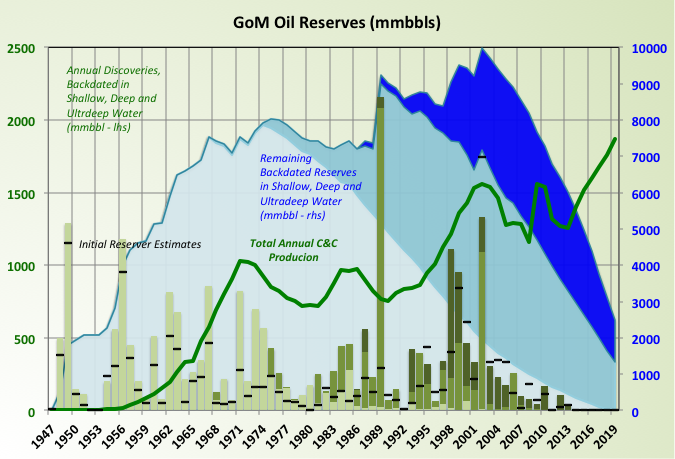
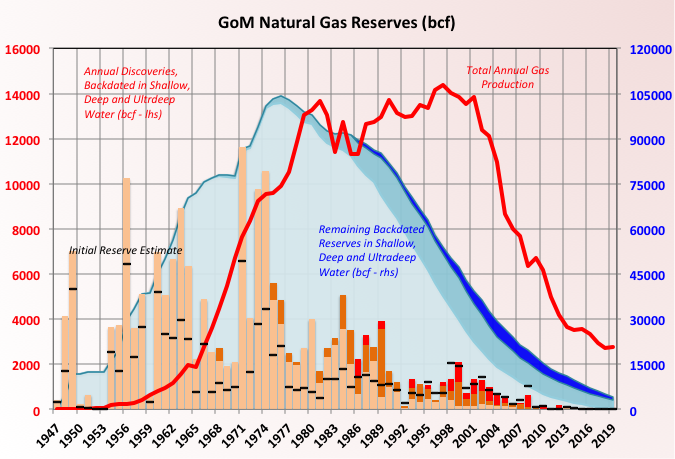
The 2018 and 2019 remaining reserves shown have been calculated assuming no additional discoveries or adjustments so they will be low. In fact the whole curve for remaining reserves will be expanded a bit as new projects get approved, allowing their resources to be booked as reserves, so that the BOEM estimates get closer to the E&P’s own figures.
The normal caveat applies to the GoM (and some other jurisdictions) in that reserves are counted against leases (i.e. geographical locations) rather than fields (i.e. distinct geological reservoirs) so that actual new discoveries can appear to be adjustments backdated against the original discovery in a lease,
Reserve Discovery Sizes
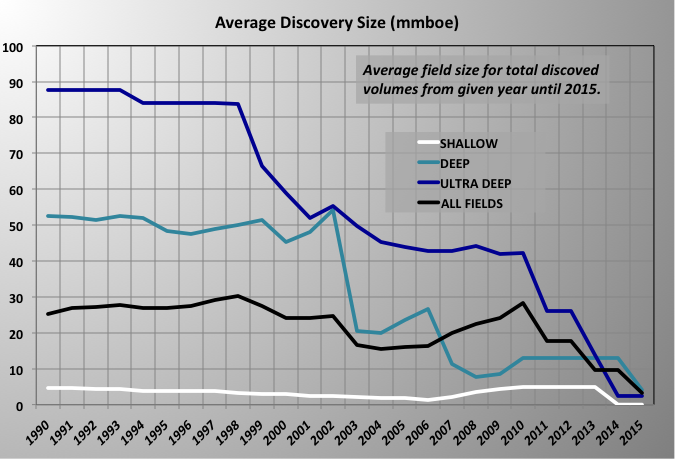
This chart might have been better shown in the previous post on discoveries, but it shows how the size of discoveries and hence the rate of addition to reserves has fallen, though probably not as dramatically as it appears just because of the way I’ve displayed the date. This possibly demonstrates how easily a particular viewpoint can be emphasized just by picking a particular way of presentation, without needing to cherry pick data. That was not my idea – at least consciously. The lines show the average size of total reserves for all the fields found from the year shown until 2015 (the last year with many recorded). This smooths out yearly variation but overly biases towards recent years and means that the delay between discovery and registration of a find by SEC rules makes the curve look steeper than reality. If and when (and with the recent price crash it may now more be a question of if for some time) the newer, and relatively significant discoveries like Anchor Appomattox, North Platte, Kings Quay etc. are included then the decline in discovery size will be much less obvious. However the actual number of fields found will still follow a pretty good bell curve, and given the likely coming collapse in high risk / high impact exploration, one without a very fat tail (for now).
Reserve History
The two charts below show how the oil and gas reserves were thought to stand on a particular year. The numbers evolved for four main reasons: 1) Technology improvements and production results allow a better understanding of what is actually in-place (the reason why all reserves need to be backdated to make much sense); 2) New technology allows improved recovery; 3) Oil price changes affect what is economic to extract; and 4) SEC rule changes affect what reserves can be booked (principally affecting non-producing reserves and when they are planned for development).
The 2008 SEC rule changes show up as a big step down for oil – most of that has now come back as projects have been approved for development; it remains to be seen if they all remain as firmly approved as once thought given the ongoing price crash and the, likely, continuing short term demands from shareholders for dividends and share price support through buyback schemes) Deep reserves (anything in above 1000ft water depth) are shown by discovery year, with the three largest years highlighted. Shallow reserves have been flat or even slightly declining, something that may accelerate and become permanent downgrades if any of the high water cut wells need to be shut-in.
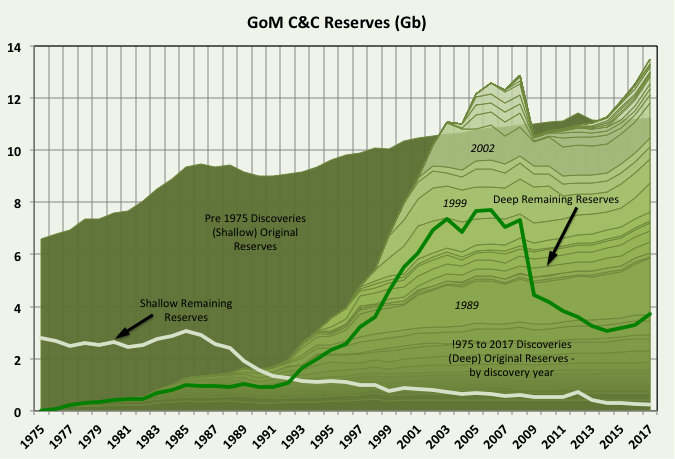
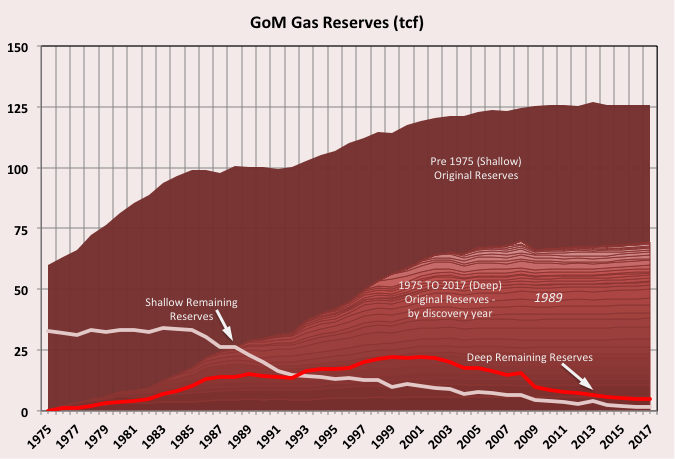
Adjustments to Large Deep Fields
Mars-Ursa is the dominant field in the GoM and is the gift-that-keeps-on-giving in that the original reserves keep getting bigger – I think this is almost all from discoveries of new fields in the leases rather than from upward revisions, although there were some improvements made by adding water flood. Note in the chart it is shown on the right hand axis and is over twice the size of the next largest C&C reserves. Lucius, too, has shown general improvement since start-up, though there was a slight downgrade in 2017 (I may have got this cocked-up in a previous post).
Other fields have done much less well and some have been severely downgraded after initial production results. Some of the downgrade has been recovered in 2016 and 2017 estimates and will likely continue when 2018 and 2019 estimates come out, although the current price crash may mean another downgrade now. This recovery was partly due to a lot of brown field redevelopment, such as Thunder Horse South and Tahiti Vertical expansion, but also a lot of in-fill wells and some new discoveries.
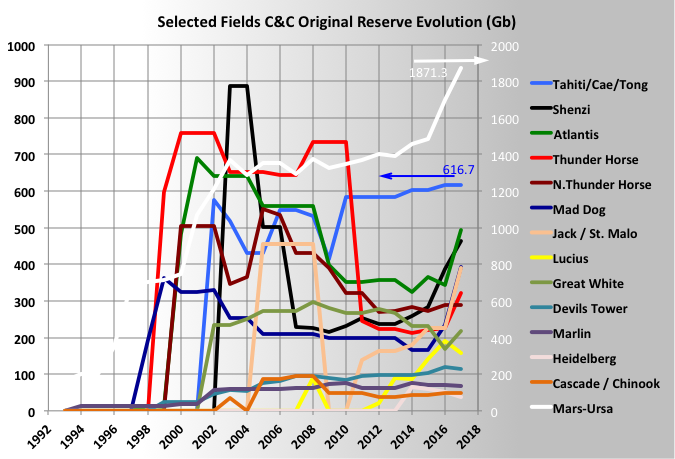
Overall Reserve Adjustments
BOEM provides historic reserve data for fields from 1975. This covers all of the period when deep and ultra-deep fields were being discovered and brought on line. The chart below shows how the reserves (all attributed to a main field in each lease) have been adjusted from the initial estimate through to when the field was exhausted or now, if still on-line. The normal caution applies in that a single lease can, and many do, contain separate fields but all reserves are referenced against the main field and its initial discovery date. Thus a significant proportion of what appears to be adjustments is really discovery of new reserves, so ‘growth’ may be over estimated (probably only the owners know by how much).
On the other hand the adjustments made for older shallow fields may be under estimates because there would have been growth prior to 1975, which as not been shown in the BOEM numbers. Some of this growth would have been very large because estimates were no better than wetted-finger-in-the-air guesses until a field started production and then improved markedly as more data became available. Because of the unknowns, and maybe because of regulatory, tax and royalty regimes, though I have no real knowledge of this, those initial estimates tended to be conservative.
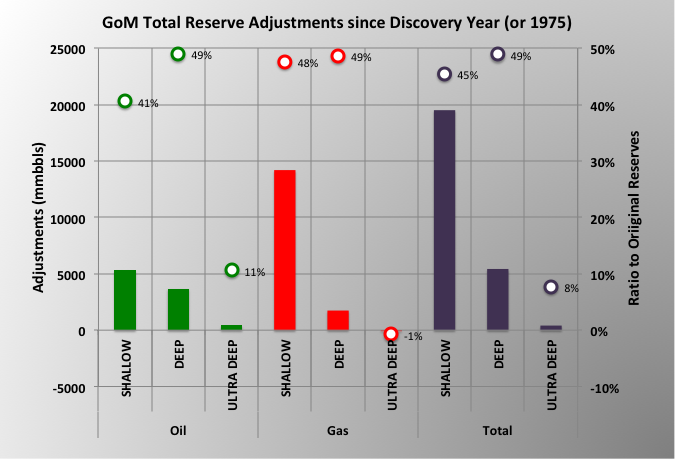
The reason ultra-deep growth is so low is because these are all newer fields, developed since 1998 when better drilling, seismic, modeling and sampling technologies have been available, together with improved understanding of the geology in the GoM and of oil reserves generally. Part of the reason the deep fields (rather than ultra-deep) adjustments are so high is that this technology became available as the fields were being developed or in early production.
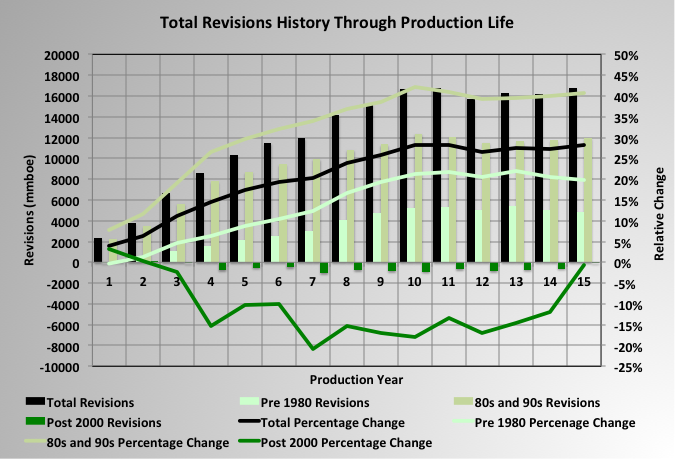
This chart demonstrates how the revisions have all occurred in the first ten years of production. I was a bit surprised that there wasn’t a bigger change in the first couple of years and then a flattening out (i.e. asymptotic rather than linear). However I might be biased by my experience having been more in the 1990s and 2000s. The newer fields haven’t shown any overall growth yet. The initial negative adjustments suggest a bit of over exuberance when these fields were first discovered (also supported by a number of highly hyped recent deep-water projects being canceled completely and some operators retreating with their tails between their legs. (Apparently dogs do that so that their foes cannot smell the fear in their chemicals in their gaseous releases – which I actually find more interesting than the history of GoM reserves, see below for more emission related information.)
The adjustments may also be affected by the small sample size with a large proportion still in early production years, by a lot of volatility in the oil price in the period where they saw changes and, as always, by the many-fields-one-lease issue.
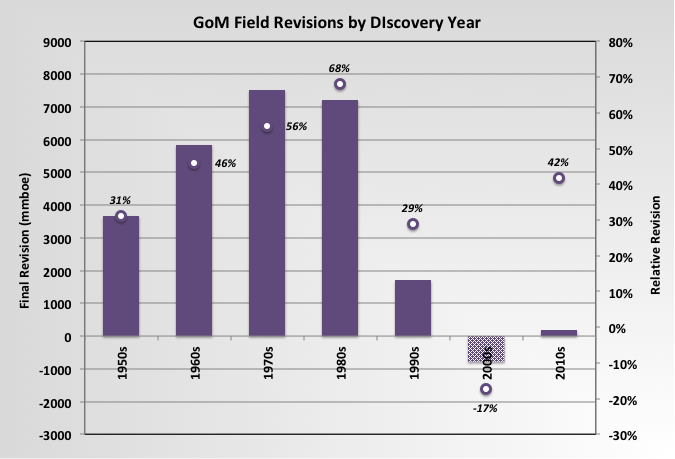
The discovery year and technology effects are summarised in this chart: large upward revisions in the 70s and 80s, not much change for fields from the 90s and probably a net negative adjustment (given the discovery versus adjustment issue), in this century. There may be further growth as production evolves but in the short term the rapid and significant oil price drop in recent weeks could be a devastating to any expectation of growth in 2P reserve numbers (both reducing current estimates by halting brownfield work but, more so, by delaying or eliminating additions from new developments and discoveries.
There have been at least two papers, one based on UK offshore and one by the USGS, warning against applying growth figures based on any one field, let alone a basin, to anything else; so these findings may be interesting but of no particular relevance; though I think it’s pretty certain that any field that’s been operating for over five years will not see much more growth unless some major EOR scheme is applied, which isn’t going to happen in many places at present prices.
R/P Ratios
Over the years the reserve to production ratio has been kept around eight years, even as the production was increasing – i.e. reserves were increasing too, I think a lot has been from reserves added back in that were dropped when the SEC rules for booking were changed, often through in field brownfield projects.
The chart shows how R/P would drop through 2018 and 2019 given the production reported for those years if no new reserves were added to the BOEM 2017 numbers.
For 2020 and forward it is hard to see how the COVID-19 crisis won’t have some major impacts, which are, at least for me, completely unpredictable. I don’t know how quarantine would work offshore; I guess the shifts have to be kept isolated even when they move onshore. Any sort of planned, still less unplanned, maintenance seems problematic; and what happens if a hurricane or major incident requires evacuation. I think the majors would be inclined to take the safe route and just shut down. Maybe Trump will insist on keeping things running for the economy and blame the subsequent deaths and hospitalisations on the Chinese. Loss of production will put the R/P number up quite quickly.
On the other hand new projects are sure to be delayed or even cancelled. Through 2019 a break even price of around $30 for deep-water had been mentioned by companies, though Art Berman has mentioned around $60. Either seems unlikely at the moment (today, 20th March Mars US, a GoM grade, is $19); and any quarantine impact is bound to delay projects, which could mean some reserve additions have to be deferred. Given that R/P might fall compared to expectations after 2020. Who knows?
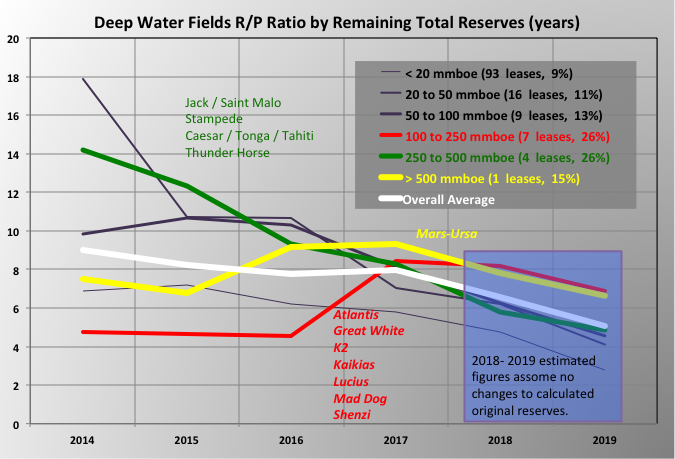
EIA Reserve Estimates
The EIA present it’s own reserve estimates based on reports from the E&Ps. These are, nominally 1P numbers but since the SEC rule changes have always exceeded the BOEM 2P estimates, although they may be getting a bit closer together. A lot of the difference may be the “non-producing” category used by EIA, which I assume is mostly fields under development, both greenfield and brownfield, of which there are some quite large ones (Anchor, Kings Quay, Vito, some adjacent fields to Appomattox, maybe North Platte depending on the level of certainty EIA require to include the resource, Oarse, Mad Dog II, Atlantis III, and who knows what other brownfield extensions). The EIA numbers are for 2018 and a lot of those developments may show up in the BOEM estimates for this year. 2019 and, certainly, 2020 will not show the same level of AFD activity, there may even be a chance some things are cancelled.

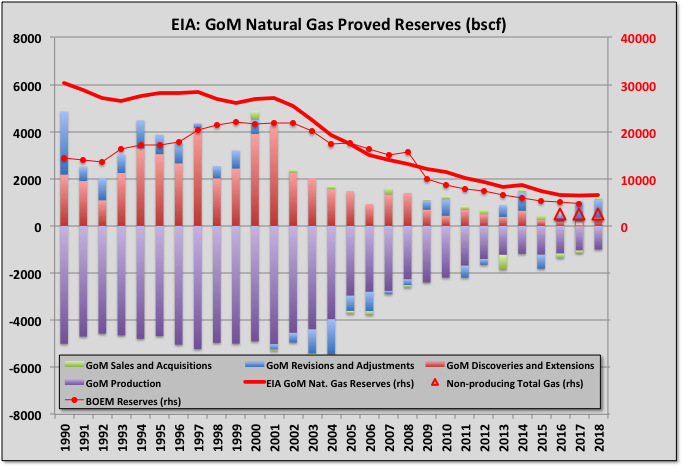
Off Topic Finish: Titian’s Effulgence
This is an early painting by Titian called “Bacchus and Ariadne”. It’s an imposing canvas and in the National Gallery it is paired opposite another big, classically themed but late period Titian with hints of impressionism (maybe because of eyesight problems, like Monet): “The Death of Actaeon”, and there are a couple of similar others in the same room if I remember correctly. Even after almost 500 years the colours are awesome, unsurprisingly especially the blues.

Nominally it is about love (really lust) at first sight, but actually it is a joke about excessive gaseous emissions, and all the greater for it. The white flower at the bottom, pointing accusingly at the nether regions of both Bacchus and the Satyr, is a caper, known for its anti-flatulence properties. The dog looks suddenly quite interested and the followers faintly disgusted, two of them may be fanning their noses; even Ariadne is looking a bit miffed (though that could equally be explained by her having a priapic Bacchus suddenly violating social isolation conventions). Some think it’s Bacchus himself who has just cut one (possibly first date nerves) but I think he’s jumping to evacuate the contamination zone, his cloak blowing in the wind as it were, and the real guilty party is the Satyr (lauded in ancient Greece for their “farting prowess”) despite his attempt at doe eyed innocence. Why would Titian have painted this? It must have been a dig at someone, probably a rich client – real art
George Kaplan,
You have just made my morning and I thank you.
This is the finest critical examination of a painting I’ve come across in a long time.
(hmm…a bit early for Port though)
Glad you and h-i-h (and I hope others) liked it. I managed to cut off the last line. It should have read: “real art historians probably know this as common lore, but I haven’t seen an answer, and maybe prefer not to know.” But maybe it reads better the way it actually came out.
George Kaplan,
I’d say it reads fine. A nice snappy ending.
thanks again
https://tomluongo.me/2020/05/07/trump-kick-saudis-curb-terrible/
US fear that such high dollar weapons are of limited use in an asymmetric conflict?
Mr Kaplan , I confess to not being an oilman , but I always read your posts because you are the man^ to go to^when it comes to GOM . I always read your ^ off topic ^ , that is enlightening . Tks ,keep plugging .
What are the regulations for cap and abandon on GoM wells?
Saudi Arabia says it will cut oil production by an additional 1 million barrels per day
Beginning on June 1 the Kingdom will cut output by an additional 1 million bpd, which combined with the cuts agreed to by OPEC and its oil-producing allies, brings Saudi Arabia’s total cut to roughly 4.8 million bpd below its April record production level. Production for June will now be 7.492 million bpd.
TAPS winding down
https://twitter.com/AlyeskaPipeline/status/1259877280341307392?s=20
What is the minimum flow Taps can have before it freezes solid?
Over the years there have been about 8 different levels of flow specified for absolute minimum.
There is no minimum flow until September – no freezing in Alaska at the moment.
Sorry all.
Forgot to renew the hosting subscription so site was down.
My sincere apologies. All should be well for a year. Will set to automatically renew so this doesn’t happen annually.
Thanks George. I’m always impressed with the data-rich nature of your charts. One could spend half an hour just digesting one of them.
As your first chart shows, GOM production has been at all time high levels. Average production for 2019 was an all time high of about 1.89 mmbopd, exceeding 2018 levels of about 1.76. And the first 2 months of 2020 were continuing that trend. I suspect we will see some drop off in March, with that trend likely to continue as long as prices stay so low. Most big operators are still producing at high levels, with the thought that as long as they are staffing the facilities and keeping them up and running, they may as wells keep the wells open. That is, as long as they can cover their operating costs, they will keep things running, even with, I believe, reduced personnel due to COVID. Some of the smaller operators, mainly on the shelf, have shut in some production. I’ve seen press releases referencing Fieldwood and Cantium specifically.
Development drilling activity on producing assets has been greatly reduced. This is going to start showing up in GOM production later in the year. Exploration activity has been reduced as well. I suspect exploration activity will even be more focused on drilling wells on leases that are about to expire. I haven’t heard anything yet about BOEM granting blanket 1-year lease extensions. They did do something along those lines after the Macondo incident 10 years ago. (There is talk of royalty relief though.)
Some drilling activity is continuing on sanctioned projects where facilities are also being fabricated. BP’s Mad Dog 2 and Shell’s Vito are examples. Also, Shell is drilling as they continue ramping up Appomattox. Shell is actually as active as anyone as they are continuing some drilling activity in the Mars-Ursa area, and the Great White area.
As per the latest Scout report, only about 20 rigs are active in the GOM. This is the lowest I’ve ever seen. And, there is currently no drilling activity on the shelf – all deepwater.
Other projects – those that either have not been sanctioned, or even if they have been sanctioned, facility fabrication or development drilling has not started, are being deferred, or at least slowed down. Shell’s Whale and Chevron’s Anchor and Ballymore are examples. Also, LLOG has delayed further work on Shenandoah and Leon.
Thanks for the update; it’s always better to get direct info. than anything I can get from just looking at the data and a few press reports or company documents. I’m going to attempt another projection for GoM sometime this year despite being pretty wide of the mark last time. Hopefully you can find time to critique/demolish it.
+1
Thank you George and SouthLaGeo.
Thanks George—
Interesting EIA weekly.
I think the market is mistaken if it thinks adequate volumes of oil will be supplied in the US with WTI at $25 or below, especially considering how weak May spreads in the field are to WTI.
It might be a bad thing that a few daft shale CEO’s stated they would resume growth mode at WTI $28-30. Will keep a short term lid on prices, will keep more wells shut in. Will stack more rigs and frac spreads.
Will set up fuel shortages if demand returns closer to normal.
OXY has something like $56,000 of long term debt per BOE, plus owe Warren B another $15,000 per BOE in preferred stock. OXY wasn’t going to survive at $55 WTI
Making employees competitively bid severance. What will they think of next.
The Sheeple can’t handle the truth? The discussion should be the magnitude of this non-linear step function? https://oilprice.com/Energy/Crude-Oil/Is-EIA-Data-Disguising-A-Disastrous-Decline-In-US-Shale.html
Does anyone recall an estimate for EROI for LTO “assets”?
over the years there have been numerous attempts at EROI. Shale and otherwise.
I don’t think any of them survived detailed criticism.
It all depends on world wide economic recovery.
Normally, 20$ oil leads to 100+$ oil, since nobody can and want to invest anymore. Now there is a new situation – is global demand depressed by round about 10 mbpd for a longer time. Then oil prices will stay down longer – and production capacity will be damaged even more. At some time, even the oil giants can’t continue to build out offshore any more at these prices. Perhaps the US ones can because of the FED (they will just get 100 billion$ for 30 years 0%), but all other can’t.
So after a few years there will be a complete messed up scenario: The old cheap giant fields are worn out more, still producing. And all other oil is in sharp decline due to not investing in these high decline ressources. And the offshore supply industrie is liquidated and has to be rebuilded.
So a recovery can’t count on cheap or even halfway payable oil – at least not fast. Global peak oil in 2018 is getting more and more propable.
Eulenspiegel,
Perhaps, difficult to say how fast economy and oil demand recover, tight oil can ramp pretty quickly, the wells already producing offshore can perhaps be choked back and then ramped back up as demand recovers. Much depends on the price of oil, if there is a shortage and oil prices are higher than $80/bo we might see frenzied investment in the oil sector, and the higher the price, the greater the investment. Even tight oil (probably the highest cost oil in the World) is profitable to produce at more than $80/bo in 2020$ for Brent oil price.
Shallow sand,
Yes these tight oil CEOs are daft. The more daft their claims, the higher their paychecks I guess.
Mostly they need about $60/bo at wellhead for a newly completed well to be profitable, and that price needs to be maintained for 5 years at least for the well to pay out. Perhaps 2 to 5% of tight oil wells drilled pay out at $30/bo (and my estimate may be too optimistic, maybe it is less than 1%).
What price are you looking for for WTI, before it makes sense to start back up? I am guessing maybe a couple of months over $50/bo? Hope you are hanging in there, the EIA STEO is forecasting about $48/bo for WTI in Dec 2021, typically their forecasts are not very good, as you know well.
Dennis.
We will reactivate leases based on historical LOE per BO. We did keep a few low cost wells running the whole time, maybe 5%. We are up to about 15% now, will reactivate more next week if price holds. Some won’t come back on until we see $40s consistently.
Dennise ^Perhaps, difficult to say how fast economy and oil demand recover, tight oil can ramp pretty quickly, the wells already producing offshore can perhaps be choked back and then ramped back up as demand recovers.^
No, not perhaps ,and also not difficult . Their is no going back to $50 (except for a spike) . The party is over and the music is playing . There is no going back to normal because normal has already left the station . You mostly end our disagreement with ^ my crystal ball is not clear ^ . Well for the first time ,mine is and I suggest in the time of CV 19 get a good sanitiser to clean yours .;-)
hole in head,
I am confident that neither of us knows what the future will bring. One of us thinks that they know, but they are wrong. 🙂
I am steadfast in my belief that the future is unknowable.
Note that speed of recovery was not predicted, from the bottom will range from zero to infinity. I think that covers most possibilities. Note that my guess is that the probability of zero growth in demand for oil from the nadir is approximately zero, likewise an infinite rate of increase in oil demand also has zero probability. Otherwise I don’t know. the possibilities are pretty much infinite for the path of recovery.
Why do people assume there has to be a recovery? What i’m seeing is a insolvency issue and it’s not just in oil. It’s absolutely everywhere you look. 2008 was a liquidity issue. This is a totally different breed of crisis.
Central banks can offer up whatever loans they want. They can buy up whatever they want. And it makes no damn difference. They can set interest rates wherever they want to. Be it positive or negative or just zero and it makes no difference. Worse thing anybody could own right now is DEBT. Because the defaults that will be associated with this event are just getting started.
I’m in the opinion that we are just at the tip of the iceberg of this crisis. And we have so much further to fall it can’t really be comprehended. No vaccine will come and no viable treatment. and herd immunity 60-70% of population exposed is years away. Maybe decades if we continue social distancing. And all the CB’s and governments have already went all in.
Having said all that i still believe there is a way forward to higher oil price. Scarcity. Now throw higher oil prices on top of everything and think about the outcome.
The Atlanta Fed’s GDPNowcast says -45% Q2 GDP.
It won’t stay that number. It’s a nowcast snapshot and next week it could be different.
End of quarter -24% called from Goldman a few weeks ago. Maybe. The reopening happening all sorts of places will cause a sharp rise from a -45% trough, though reopening in order to serve no customers will not get GDP back to 1 Jan. But it will be a sharp rise. Maybe even quarter to quarter all time record.
There are a zillion experts starting their paragraphs with “the real problem is”. And they all have something different for the real problem. Truth . . . there are a lot of real problems.
I would guess the Democrat governor perspective of lockdown is going to disappear within a few more weeks. Being the party of lockdown and miserable people is probably going to lose votes. The “principled” perspective of . . . I will not let people die, will soon fade when campaign managers point out that if you lose then everything is going to re-open anyway, so might as well do it so you can keep your job and slow it down and I can keep my staff job. Usually pretty easy to find a moral position consistent with winning.
This will steepen a rebound, which of course the President’s campaign people are expecting and will celebrate. All time record for growth!!
But once past politics $28T will be there (assuming more stimulus). $28 Trillion big ones. It says there can never be inflation again because if there was, rates would have to follow it. 5% interest rates on 28T . . . $1.4 T interest on the national debt. For a GDP of 17-18%. We’ll be servicing the debt with 6% of GDP each year. This is insanity territory.
HHH and Watcher ,100% agree with you . Not so difficult to understand if you don’t smoke ^hopium^.
Central bank can buy up the debt and foregive it. Solvency crisis solved on a magic way.
Yes that’s possible, and already thought at. It’s a step nearer to a DOW of 1 million+. Blow up the currency system and restart it, without the debt.
I know in the USA you have never done this, but in other countries it is done every now and then. It helps a lot with cleaning up, and after this reset the time for 0 interrest rates are over, too.
For all people fearing this and having a bit of wealth: Buy stocks, houses (or one or tho new oil leases for the oil men here, or a new pump). Just don’t sit on money in every form. Get rid of debt – the last time can be ugly (sudden repay).
US frac spread count now at 45.